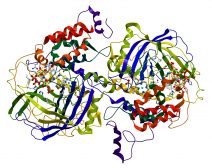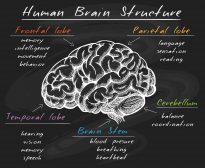Effect of Chemicals on Growth & Development in Organisms

Chemical effects on plant growth and development
Table of Contents
Plants
Plants require a large number of elements to function properly, mainly carbon, oxygen, and hydrogen, essentially used in many biochemical pathways.
In addition to these essential elements, plants also require a dose of nitrogen, phosphorus, potassium, and magnesium. A well-known fertilizer used to increase crop yield is nicknamed NPK, the chemical symbols for the first three of these macro elements.
A lack of any of these elements can result in the following phenotypes
- Lack of nitrogen causes excessive growth of roots and a red leaf base
- Lack of phosphorous also presents a red leaf base and stunted growth of roots
- Lack of potassium can lead to similar effects to lack of phosphorous
- Lack of magnesium can result in pale leaves due to a lack of pigmentation
Herbicides
Herbicides are artificially created chemicals that are used by humans on plants considered as ‘pests’. These may be weeds in someone’s garden, a farmers crop, or an undesired influx of a species into a foreign environment.
They are effective by accelerating the plant’s metabolism rate to such an extent that food supplies are totally exhausted, leaving the plant to die. Herbicides are applied by humans to destroy these pests and minimize competition for the other desirable plants in the area.
Humans and Animals
Humans and animals have to actively find sources of food to be used in their bodies. Their body requires a variety of substances, e.g. proteins, carbohydrates, vitamins, minerals, and fats. There are also many macro-elements which are of use to the body. However, some elements are also dangerous to the health of animals, as indicated below.
Carbon dioxide
Carbon dioxide is a compound made up of a carbon atom and two oxygen atoms. In its gaseous form, it is colorless, odorless, and incombustible. In humans and animals, carbon dioxide accumulates in the tissues and is removed from the body during exhalation. It is, therefore, a metabolic byproduct of carbohydrate metabolism, particularly cellular respiration wherein carbohydrate (or lipid) is metabolized to synthesize metabolic energy such as ATP. However, this compound can be detrimental to health when at high levels, such as in enclosed spaces or when staying most of our time indoors. Human breathing can augment carbon dioxide levels in the air. As the body inherently produces carbon dioxide from metabolic activity, it must release this gas through exhalation. Thus, spending a long time in enclosed spaces could become detrimental to the body because the air is made substandard by a significant increase in carbon dioxide levels. When the body inhales carbon dioxide, it could suffer from hypercapnia, i.e. a condition wherein carbon dioxide level is excessively high in the bloodstream due to improper respiration. An unhealthy level of carbon dioxide could bring adverse effects to the body, particularly the brain. The blood flow in the cerebrum is heightened from the subsequent dilation of cerebral arteries and arterioles from inhaling too much carbon dioxide. This means the body will not be able to metabolize oxygen. As it will not be able to use oxygen efficiently, this could hamper normal brain activities, such as cognition. Thus, if one fails to focus and is having a hard time making logical decisions and complex thinking, it might have something to do with high carbon dioxide levels in the air. This makes proper ventilation crucial to ensure quality air. (Ref. 1) Read more about facts on ventilation here: Ventilation Factsheet: Fundamental Biology for Enclosed Spaces.
Lead
The presence of lead in the bloodstream can cause a variety of complications to the animal at hand. Lead can lead to brain damage, and prevent the action of the enzyme catalase, which is responsible for the breakdown of poisonous hydrogen peroxide which accumulates in the body
Calcium
Calcium is required for the proper formation of bones and teeth in animals. They are also an important constituent in exoskeletons, such as the outer shell of tortoises.
Vitamins
Vitamins are required for a variety of reasons in the animal body.
- Citrus fruits are rich in vitamin C, which is required in the formation of red blood cells and antibodies. Deficiency of vitamin C can lead to scurvy.
- Vitamin A is commonly found in dairy products and is required for growth and night sight. Lack of vitamin A can result in stunted growth and night blindness
- Vitamin D is obtained by humans from sunlight, but can also be found in some dairy products and fish. It is required for the absorption of some materials into cells and the lack of it can result in rickets, a softening of the bones.
More information relating to vitamins and a balanced diet is available in the Developmental Biology tutorial.
Iron
Iron is a constituent of some enzymes, and also forms cytochrome, required in respiration, and hemoglobin, which is a respiratory pigment responsible for absorption of oxygen. Anemia is a condition resulting in iron lacking in an animal’s diet, which results in a lack of red blood cells, or a depletion of hemoglobin content.
Nicotine
Nicotine is a mild stimulant found in tobacco plants and can be smoked or chewed. It contains thousands of carcinogenic substances, most notably carbon monoxide and tar. Carbon monoxide is poisonous and found to be around 200 times more absorbable into the bloodstream than oxygen, therefore reducing the amount of oxygen available to the body through the bloodstream.
Tobacco has been found to cause cancer, narrow the arteries and generally lead to declining health due to its numerous substances taking their toll on the body. Nicotine is smoke to produce a mild relaxing effect and is believed to induce a feeling of psychological dependence.
Alcohol
Alcohol is also a poison to the body, yet it produces a stimulating effect on the nervous system, and produces a relaxing effect as a depressant.
Alcohol has a toxic effect on the liver and also affects the uptake of certain ions in the body, and in this instance can prove lethal to an unborn child.
For men, it is believed that alcohol can damage sperm production and lower sperm count over the longer term. Alcohol can be physiologically and psychologically addictive, with withdrawal effects including delirium, high blood pressure and a high risk of liver disease.
To conclude this tutorial, the next two will deal with the effect of light on growth and growth patterns.
References:
- Ventilation Factsheet: Fundamental Biology for Enclosed Spaces. (2019, October 8). Building Biology Institute. https://buildingbiologyinstitute.org/free-fact-sheets/ventilation/
- The Phosphorus Cycle. (2013). Science Learning Hub. https://www.sciencelearn.org.nz/resources/961-the-phosphorus-cycle
You will also like...

Protein Variety
The sequence of amino acids determines the type of protein. Protein is synthesized according to the sequence of nucleoti..

Early Mammals on Earth
The Earth's ecosphere was rapidly changing and throwing up a wide range of ecological niches that new adaptive organisms..

Human Reproduction
Humans are capable of only one mode of reproduction, i.e. sexual reproduction. Haploid sex cells (gametes) are produced ..

Protein Activity and Cellular Metabolism
Proteins have a crucial role in various biological activities. Get to know how proteins are able to perform as enzymes, ..

The Conscious & Unconscious Nervous System
This tutorial elaborates on how the nervous system works, particularly at the tissue level of the brain. There are three..

Plant Tissues
Plant organs are comprised of tissues working together for a common function. The different types of plant tissues are m..
